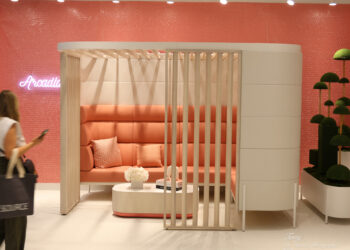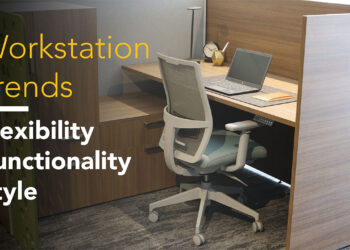Workstation Trends: Flexibility, Functionality, and Style in Modern Office Design
Today’s workstations need to be more flexible, user-friendly, and stylish, with modular storage and adjustable options that meet a wide range of needs. At NeoCon 2023, I saw some exciting updates in workstation design that reflect these trends, especially in the AIS line.
Here are some highlights that are shaping the future of cubicle/workstation design:
- Slim Profiles and Modular Components: Interior designers now have a wide array of products to work with, beyond the classic 2- or 3-inch-thick panels that traditionally defined spaces. New options like power beam systems with detachable screens, expanded storage solutions, and slimmer gallery panels—each designed to be added or removed as needed—blur the line between a traditional workstation and a benching station. These innovations make open-plan furniture layouts more flexible, both during initial design and for future reconfigurations.
- Sit/Stand Flexibility with Height Adjustable Tables (HATs): Height-adjustable tables are no longer just a novelty; they’re here to stay. Available in two main configurations—two-leg and three-leg bases—these sit/stand tables accommodate various work styles. The two-leg base supports a single surface, while the three-leg option supports an L-shaped configuration, allowing the entire worksurface to be raised or lowered. Whenever possible, I encourage clients to select the three-leg base because it offers greater flexibility, and clients love the versatility it provides!
- Revolution in Personal Storage: Traditional workstations once relied on basic storage solutions: file cabinets beneath the desk and perhaps a flip-door bin above. Now, personal storage options have expanded, with mobile box/file pedestals, multi-drawer configurations, and the increasingly popular storage towers with wardrobes. Storage solutions used to be mostly metal, but laminate storage units are growing in popularity. Woodgrain laminate adds a natural wood look, and when paired with a gallery panel, it creates a truly beautiful and cohesive design. I’m a big fan of the storage tower with a wardrobe—it’s a more efficient use of space, often eliminating the need for overhead bins and tall panels. This allows for medium-height panels (around 50 inches), which bring in more natural light and outdoor views, compared to the taller 62-inch panels that can create uneven sight lines.
- Stylish Gallery Panels for a Finishing Touch: Gallery panels are a beautiful addition to any workstation. These can be installed in aisleways or wings of the workstation and come in laminate or PET materials. When specified in a woodgrain laminate, they can create a polished, sophisticated look. Paired with matching laminate storage, gallery panels bring an elevated design aesthetic to the entire open office.
- Accessories for Enhanced Functionality: Today’s workstations can feel as personalized as private offices, thanks to practical accessories. Some of my favorites include:
- Dual Monitor Arms: For better ergonomics and flexibility.
- Task Lights or Desk Lamps: To provide focused lighting right at the worksurface level.
- Worksurface-Mounted Power Modules: For easy access to power outlets without crawling under the desk.
These additions make workstations not only more comfortable but also more efficient. As I mentioned at the start, open-plan designs demand more from a workstation (especially post-COVID), and furniture manufacturers like AIS have delivered. A workstation has become more than just a place to sit—it’s an adaptable, multifunctional space that supports diverse work needs. Whether it’s a height-adjustable table, streamlined storage, or stylish gallery panels, the right components can transform any cubicle into a productive and visually pleasing workspace.























